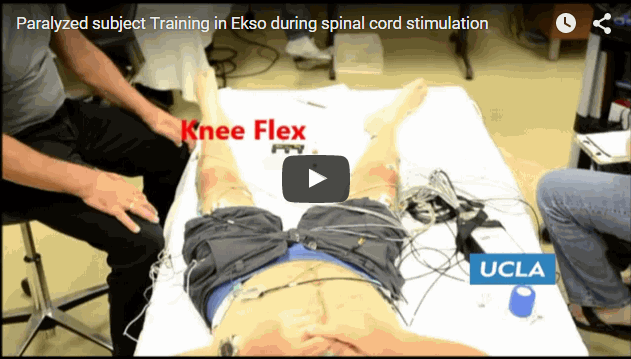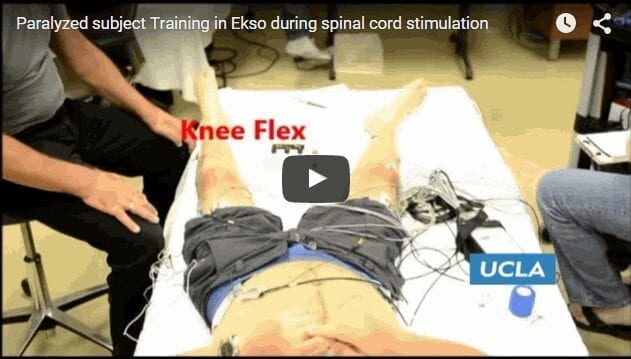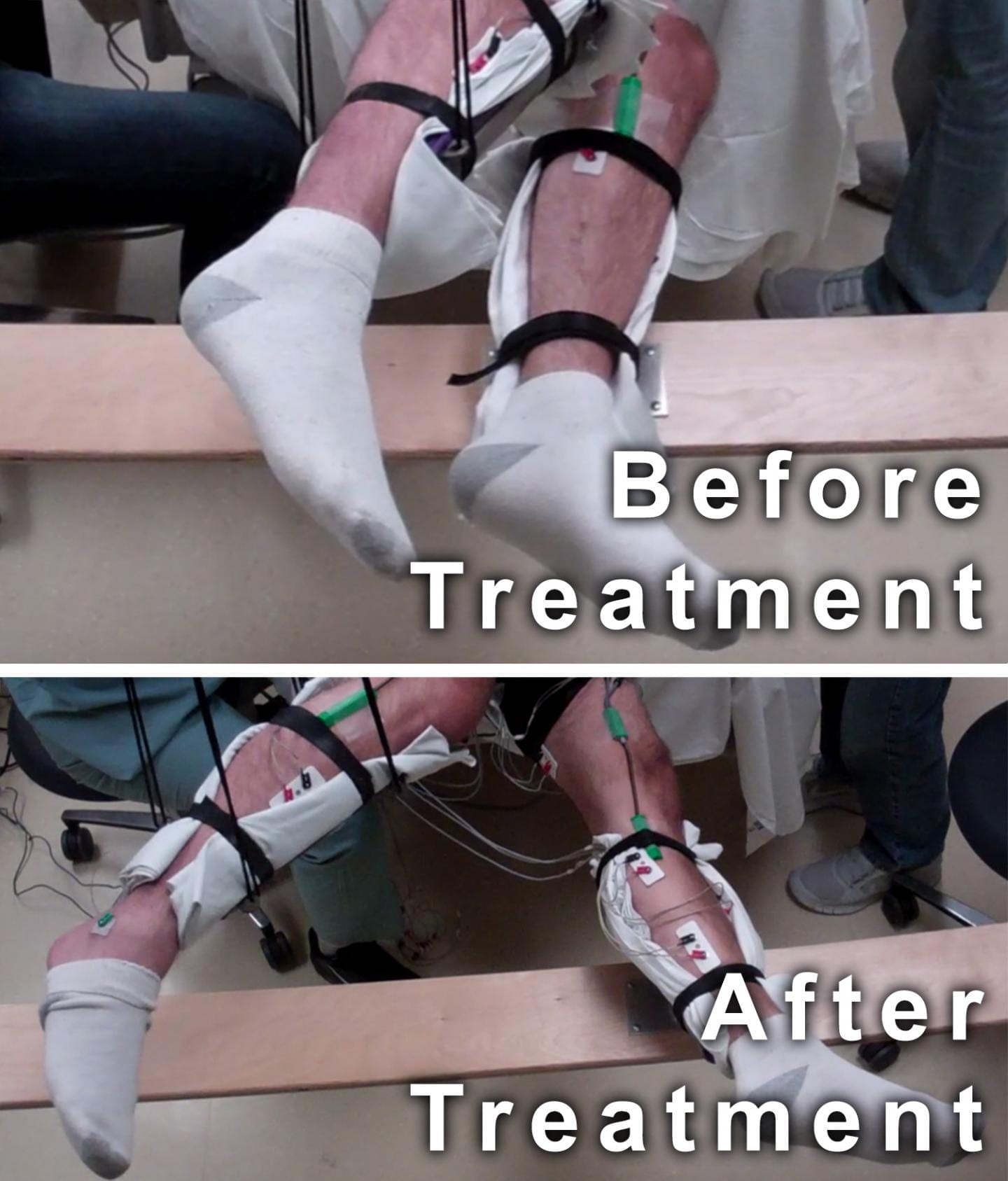
Robotic step training and noninvasive spinal stimulation enable patient to take thousands of steps
A 39-year-old man who had been completely paralyzed for four years was able to voluntarily control his leg muscles and take thousands of steps in a “robotic exoskeleton” device during five days of training — and for two weeks afterward — a team of UCLA scientists reports this week.
This is the first time that a person with chronic, complete paralysis has regained enough voluntary control to actively work with a robotic device designed to enhance mobility.
In addition to the robotic device, the man was aided by a novel noninvasive spinal stimulation technique that does not require surgery. His leg movements also resulted in other health benefits, including improved cardiovascular function and muscle tone.
The new approach combines a battery-powered wearable bionic suit that enables people to move their legs in a step-like fashion, with a noninvasive procedure that the same researchers had previously used to enable five men who had been completely paralyzed to move their legs in a rhythmic motion. That earlier achievement is believed to be the first time people who are completely paralyzed have been able to relearn voluntary leg movements without surgery. (The researchers do not describe the achievement as “walking” because no one who is completely paralyzed has independently walked in the absence of the robotic device and electrical stimulation of the spinal cord.)
In the latest study, the researchers treated Mark Pollock, who lost his sight in 1998 and later became the first blind man to race to the South Pole. In 2010, Pollock fell from a second-story window and suffered a spinal cord injury that left him paralyzed from the waist down.
At UCLA, Pollock made substantial progress after receiving a few weeks of physical training without spinal stimulation and then just five days of spinal stimulation training in a one-week span, for about an hour a day.
“In the last few weeks of the trial, my heart rate hit 138 beats per minute,” Pollock said. “This is an aerobic training zone, a rate I haven’t even come close to since being paralyzed while walking in the robot alone, without these interventions. That was a very exciting, emotional moment for me, having spent my whole adult life before breaking my back as an athlete.”
Even in the years since he lost his sight, Pollock has competed in ultra-endurance races across deserts, mountains and the polar ice caps. He also won silver and bronze medals in rowing at the Commonwealth Games and launched a motivational speaking business.
“Stepping with the stimulation and having my heart rate increase, along with the awareness of my legs under me, was addictive. I wanted more,” he said.
Read more: Completely paralyzed man voluntarily moves his legs, UCLA scientists report
The Latest on: Robotic exoskeleton
[google_news title=”” keyword=”Robotic exoskeleton” num_posts=”10″ blurb_length=”0″ show_thumb=”left”]
via Google News
The Latest on: Robotic exoskeleton
- Global Medical Robots Industry Research 2024-2029: Acquisitions, Product Launches, Expansions, Agreements & Collaborations, and Approvalson May 9, 2024 at 1:01 am
The "Global Medical Robots Market by Product & Service (Instruments & Accessories, Robotic Systems), Type (Surgical (Soft: General, Gynecological, Urological; Hard: Knee & Hip, Spine), Rehab, ...
- ASTM proposed standard to help maintain exoskeletonson May 6, 2024 at 9:06 am
ASTM proposed standard will provide a systematic approach to testing that will help ascertain the seamless functionality of exoskeletons.
- I Tried an AI Exoskeleton That's Like an E-Bike for Legson May 6, 2024 at 7:56 am
The DNSYS X1 exoskeleton gives you extra support on hikes, long-distance walks and can even help you run faster.
- Transform Outdoor Adventures: Dnsys X1 Exoskeleton Makes Hiking, Climbing, and Running Easier Than Everon May 2, 2024 at 7:39 am
Dnsys has launched the X1 exoskeleton, which supports up to 83 pounds and weighs less, providing improved mobility for outdoor activities.
- This company makes an AI exoskeleton to give people superhuman poweron April 17, 2024 at 3:23 pm
The nice thing, at least, is that this thing isn’t as bulky as that Sarcos Robotics exoskeleton we saw a few years back. Josh Hawkins has been writing for over a decade, covering science ...
- Robotic hip 'exoskeleton' helps patients improve walking after strokeon March 5, 2024 at 11:43 am
A new robotic hip exoskeleton could help stroke patients improve their walking stride, a new study shows. More than 80% of stroke survivors develop problems walking, often because their step is ...
- TWIN, THE NEW ROBOTIC EXOSKELETON FOR LOWER LIMBS (IMAGE)on February 23, 2024 at 3:00 am
walk with the assistance of crutches or walkers (as the exoskeleton is not self-balancing), and to stand up and sit down. In the picture TWIN wore by Alex Santucci, one of the patients who ...
- ReWalk Robotics Ltd.on February 12, 2024 at 9:42 pm
development and marketing of wearable robotic exoskeletons. The firm's exoskeletons provide hip and knee motion to enable individuals with spinal cord injury (SCI) to stand upright, walk ...
- Paralyzed student walks to receive diploma thanks to robotic exoskeletonon May 18, 2023 at 10:27 am
A Virginia college student who was paralyzed after being shot in the neck was able to walk to receive his diploma — thanks to a wearable robotic exoskeleton. Khalil Watson, 25, received a ...
- Pain-Free Skiingon April 14, 2023 at 7:36 am
SPECIAL MENTION: Roam's Elevate robotic ski exoskeleton aims to ease pain as you go down the slopes. The equipment includes a backpack and a device that resembles a knee brace, which you strap to ...
via Bing News











